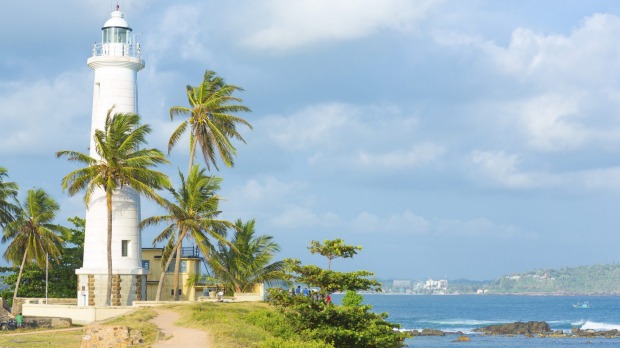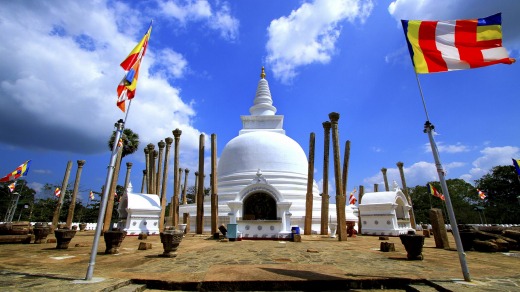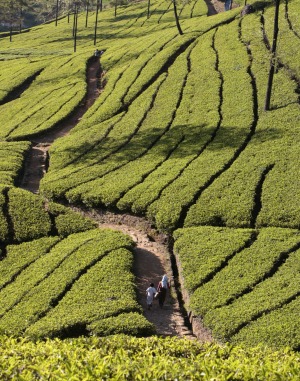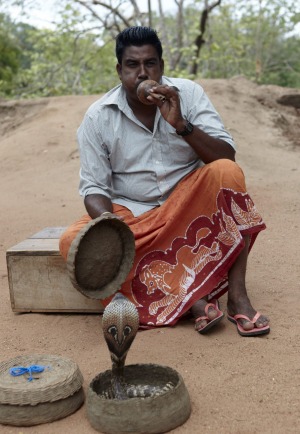
Mock Tudor melds with leopards and Buddhas in incomparable Sri Lanka, writes Christina Pfeiffer.
It's our first day on the road and already I've filled half my notebook with interesting bits of information. I've discovered the national flower of Sri Lanka is the blue water lily, the national gemstone is the blue sapphire and the national bird is the colourful Sri Lankan jungle fowl.
I've learnt that Sri Lankans like to consume herbal soup at least twice a week for breakfast - because the greens in the soup are purifying - and 70 per cent of the population are Theravada Buddhists who consult astrologers for everything from where to build a house to whom to marry.

As our small group of nine travel around Sri Lanka in a minibus, sweeping past beautiful vistas of waterfalls and tea plantations, palm-fringed beaches and ancient temples, our knowledgeable guide Priya reveals a country rich in history and culture, and steeped with mysticism.
Before I arrive, I imagine a place scarred by years of instability and conflict. Friends are curious about why I've chosen to visit a place that many seek asylum from. The civil war ended in 2009, but I'm half expecting to experience some aftermath of the years of conflict between the majority Sinhalese Buddhists and the minority Hindu Tamils. However, I feel a positive vibe throughout the island.
COLONIAL CULTURE

Our tour begins in Negombo, a seaside town 35 kilometres north of Colombo. Couples dressed in richly embroidered red and gold wedding clothes pose for photos next to historic churches and in lush gardens. A centre for cinnamon during the Dutch era, Negombo has smatterings of architectural reminders from the Dutch colonial era. The Dutch seized Negombo from the Portuguese in 1640, lost it, and then took it again in 1644.
From Negombo, we set off inland towards Sigiriya, zooming past big red public buses, tuk tuks and lorries packed with workmen. Our guide, Priya, works hard to come up with interesting ways to entertain and inform. There are tarred roads or "carpet roads", as the locals call them, and tidy villages. For travellers used to Western comforts, there are clean and readily available toilet facilities throughout the country.
We learn about Sri Lanka's geography, history and culture and gain insights into the Sri Lankan psyche, which is heavily influenced by Buddhism and Hinduism as well as Dutch, Portuguese and English colonial values.

The Portuguese brought Roman Catholicism and sailing boats. With the Dutch came engineered canals, architecture, Western hospitals, the Dutch Reform Church and Dutch Roman Law, which is still applied in Sri Lanka's courts today. When the British arrived in 1796, the country benefited from the English education system, British town planning (Sri Lanka has nine provinces and 22 districts), coffee, tea and a railway system.
There are plenty of stops to stretch our legs and lots of interesting things to see along the way. We taste local fruit, such as mangosteen, rambutan and red bananas.
Priya arranges for us to watch villagers tap rubber and make pottery. There's a demonstration of the numerous ways to use every part of a coconut tree. One of the excursions on the journey is a visit to the Pinnawala Elephant Orphanage, which provides care and protection for a large herd of orphaned elephants.
PALACES AND CAVES
Sigiriya Village Hotel is our base from which we explore the Cultural Triangle, where most of the island's eight UNESCO World Heritage sites are clustered. This zone in the centre of the island was the seat of powerful kingdoms, Anuradhapura and Polonnaruwa, and has the country's most precious ancient art.
Anuradhapura is the oldest of Sri Lanka's ancient cities and was the centre of power from 377BC until the 12th century AD. We follow Priya around stupas and dagobas, bell-shaped structures up to 60 metres high that house Buddhist relics, and to the sacred 2300-year-old Sri Maha Bodhi.
Another ancient capital, Polonnaruwa was the island's capital in the 11th and 12th centuries. It's located beside a man-made lake and is a treasure trove of ruined palaces, pools, stupas and rock sculptures. A highlight is Gal Vihara, four massive rock statues of Buddha carved into a cliff.
For me, Sigiriya (Lion Rock) and its frescoes of bare-breasted maidens is the most impressive of all Sri Lanka's ancient sites.
It was a palace built by King Kasyapa in the 5th century, situated atop a 200-metre granite rock.
VILLAGES AND FORESTS
The tour balances ancient history with cultural and nature-based activities, such as hiking through Ritigala Medicinal Forest, where we walk past streams and pools and clamber on granite boulders to explore the ruins of a meditation centre once used by monks.
Another time, we pile into jeeps at Minneriya National Park and speed along a dusty road to the Minneriya tank, a watering hole built in the 1st century AD by King Mahasena. The bumpy ride is worth the discomfort for the opportunity to get close to a large herd of elephants grazing in the open plains and bathing in the water.
On another day, we visit a village that is as yet unaffected by tourism. The villagers survive by employing slash-and-burn (chena) farming methods, an agricultural system in which the forest is burned and cleared for planting and the ash is used to fertilise crops. They grow pumpkin, okra, bananas, passionfruit, papayas, and pineapples.
The primary school children at the village school are eager to show off their singing skills.
On the road to the highlands, Priya tells us tourism is the third-largest revenue source for the country and the potential saviour of the economy.
Many Sri Lankans hope tourism will replace the country's largest income source, which is foreign employment. There are more than a million Sri Lankans working abroad and many are women who are forced by economic necessity to leave their families in Sri Lanka to work as housemaids abroad.
TEA AND TRAINS
On the way to Kandy, the Golden Temple of Dambulla is an impressive cave temple complex established in the 3rd century BC. The rows of Buddha statues and Buddhist mural paintings are jaw-dropping. Kandy is Sri Lanka's holy city and home of the Temple of the Sacred Tooth, where Sri Lanka's most important Buddhist relic - a tooth of Buddha - is kept.
Outside the temple, the British influence can be felt while strolling through the Royal Botanical Gardens of Peradeniya past green lawns and a display of botanical diversity including coffee, tea and nutmeg, rubber and cinchona (quinine) plants. There's also an impressive orchid house with an eye-catching variety of orchids.
A short local train journey from Kandy to Gompala reveals scenes of villages and forests. In Gompala, our bus driver picks us up and we drive along more carpet roads past hills blanketed in tea bushes. There's a chill in the air when we arrive in the former British hill station of Nuwara Eliya.
The hill station was developed by the British in the 19th century as an escape from the steamy lowlands. It's a picture of mock-Tudor bungalows, whitewashed walls, and gardens with roses and hydrangeas. There's a golf course, race track, botanical gardens and gentlemen's club.
LEOPARDS AND BEACHES
Back in our bus, we have acquired a vocabulary of 10 Sinhalese words and know enough to say hello, goodbye and order a glass of water. We roll past tractors, golden paddy fields and trucks piled with firewood. Cows wander across the road and monks peer from roadside monasteries.
As we head towards the coast, the landscape transforms from lush tea plantations to dry scrub, brackish lagoons, lakes and rivers. Yala National Park is one of Sri Lanka's top ecotourism destinations.
The park has elephants, wild buffalo, deer, black bears, macaques, jackals and birds but the main drawcard is its large population of leopards. Unfortunately, this time, luck isn't on our side. But that's another story for another day.
As we drive along the stunning south-eastern coastline towards Galle and Colombo, we sing the Sinhalese song Priya has taught us. A week and a half ago, at the beginning of my journey , most of us had never met one another, but by the end of the road trip through Sri Lanka, we have parted as friends, of each other and this magnificent country.
The writer was a guest of Bunnik Tours.
TRIP NOTES
TOURING THERE
Bunnik Tours' A Taste of Sri Lanka is a 17-day small-group tour starting from $4376. The price includes airfares from Sydney or Melbourne, accommodation, some meals, airport transfers and gratuities. Bunnik Tours also offers tours of Sri Lanka for independent travellers along with small-group trips for solo travellers. Phone 1800 286 645 or see the Bunnik Tours website - bunniktours.com.au.
NEED TO KNOW
Following the end of Sri Lanka's three decades-long civil war it is safe to travel throughout the country. However, it is worth reading the advice on travelling there on the federal government's Smart Traveller website, which still recommends exercising a high degree of caution when visiting the island. Seesmartraveller.gov.au
MORE INFORMATION
bunniktours.com.au